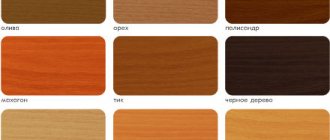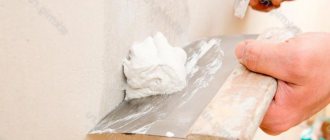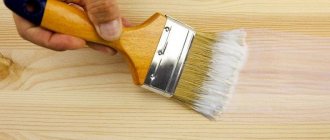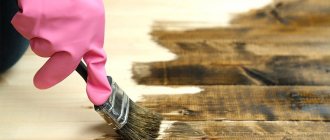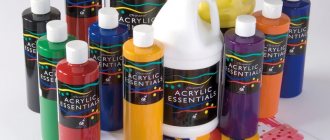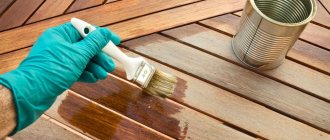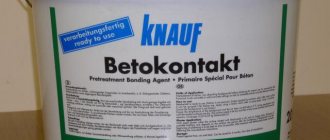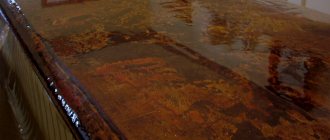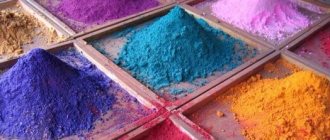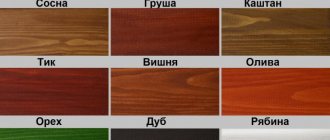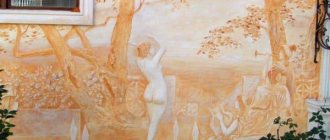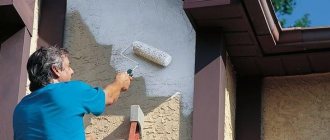Concrete structures are distinguished by their special strength, but any materials can collapse under the influence of external factors. This also applies to concrete; time and various influences lead to the spalling of part of the material, which ultimately leads to cracking of larger zones. To prolong protection and create a more attractive appearance, concrete varnish is often chosen. But you need to know which option is best. This will be discussed in the article.
Varnish for stone and concrete - composition and properties
Varnish products for concrete, stone and other similar materials can be produced using different components. Incoming elements affect the technical characteristics of the varnish. Additional products can also be used to give a certain effect to the coating: matte, glossy, semi-gloss.
The matte type helps to obtain a coating that can hide minor defects, so it is often chosen as a varnish for concrete floors when the room is heavily trafficked. The glossy layer looks more attractive.
There are also special products that have additional endurance. For example, varnishes that can withstand high temperatures are used to treat stoves, fireplaces, etc. Also frost-resistant for outdoor use. Or with increased wear-resistant properties when the coating is subjected to strong mechanical loads.
The glossy layer looks more attractive.
Benefits of use
The use of varnishes to coat concrete is popular due to the many positive effects it has on the material. The waterproof property is increased, protection against rust is created, and the strength of the structure is also improved. The following advantages of using base varnish can be highlighted:
- Increases surface durability;
- Improves the durability of the material;
- Provides abrasion resistance;
- Frost resistance;
- The appearance of the surface changes for the better.
The waterproof property is increased, protection against rust is created, and the strength of the structure is also improved.
Advantages and disadvantages
The properties of the varnish are such that the product can be used both indoors and outdoors. The paintwork material does not roll off or deform when applied. The varnish is used for any brick walls, including those located vertically, obliquely and horizontally. The presence of a large number of benefits has led to growing interest in the product. The demand for paints and varnishes is growing steadily.
Untreated brick is constantly exposed to moisture. Over time, it loses strength and gradually collapses. External walls suffer more from this “disease”. They are watered by streams of rain, beaten by hail, snow falls on them, dust and pollution stick to them. All year round, facades are subject to “attacks” from external forces. High-quality protection of the facade in the form of varnish treatment gives it the ability to repel water and resist destruction of the entire structure.
Lacquered masonry is protected from high temperatures. This ability is especially important for stoves and fireplaces. A heating device made of brick or stone becomes truly beautiful, even sophisticated. In addition, it receives long-term fire protection.
The paint and varnish coating perfectly protects buildings from the appearance of white salt stains on brick walls, which can disfigure the masonry of houses and fences. Any stone surfaces are transformed after coating with brick varnish, they become smooth and shiny. The special properties of paintwork materials do not allow dust to accumulate on the masonry.
If you take a varnish with a high gloss content, the walls take on a wet effect. With such treatment, a country house becomes like a fairy-tale mansion. The use of “wet stone” indoors makes masonry stand out. Designers often resort to this method to focus attention on a specific element of the room. Paints and varnishes on stone make facades more attractive, emphasize the richness of the texture, and speak about the wealth of the owners of the building.
Disadvantages include the presence of specific odors, as well as the need to work using personal protective equipment for both the skin, eyes and respiratory tract.
Brick is the most popular building material; it is used both for the construction of multi-story buildings and for laying stoves and fireplaces. Such structures are distinguished by their strength, aesthetic appearance, and durability. However, due to precipitation and seasonal temperature changes, cracks form on it over time, which gradually expand. To prevent the destruction of walls, the formation of fungus and mold, experts recommend using special impregnations and varnishes for brick bases. They help maintain the attractiveness of the building's facade, as well as improve its performance characteristics. Today in any hardware store you can find a huge assortment of paints and varnishes. Each of them has its own nuances related to application technique, consumption, operating conditions, and cost. In this article we will figure out which brick varnish is best to choose to get the desired effect.
Types of varnishes for concrete
It is important to choose the varnish correctly; only then will you receive the necessary protection and reliability of the coating. It is necessary to take into account whether the product is used for external or internal work; the requirements for properties in these cases will be different. It’s easier to choose when you know the compositional characteristics of the types, so the existing types of varnishes will be discussed below.
Some craftsmen prepare the varnish themselves using polystyrene foam.
It is important to choose the varnish correctly; only then will you receive the necessary protection and reliability of the coating.
Acrylic and silicone resins as a base for varnish
Acrylic and silicone types are expensive. But the composition is convenient to use; you only need to apply one layer to get the desired decorative and protective effect. A matte coating remains on the surface, which can hide minor flaws in the base.
The composition is convenient to use; you only need to apply one layer to get the desired decorative and protective effect.
Polyurethane varnish
Polyurethane varnish for concrete is especially popular among other types. It is distinguished by its high ability to penetrate into small cracks in the base to ensure complete protection. There is also a special polyurethane-based impregnation, which helps to further enhance the effect.
A reliable barrier is created to prevent moisture from entering the material, and the layer is also wear-resistant, which helps extend the service life of the structure. The cost of the products is low, which further increases the demand for varnish.
It is this type that is usually chosen for treating floors in public institutions, garages and other utility rooms, where operating conditions are characterized by increased loads.
It is distinguished by its high ability to penetrate into small cracks in the base to ensure complete protection.
Polymer varnish for concrete coating
Polymer varnish is also in demand; it helps create a durable coating with protection from various influences, depending on the incoming additives. The compositions typically use styrene. The advantages of such funds are considered to be the following:
- Does not wear out from external influences;
- Improves the strength properties of concrete pavement;
- Water resistance is better than the previous type;
- A barrier is created for various strong influences;
- Drying does not take long, so repair work can be completed faster.
In addition, the cost is low, even taking into account the positive properties described above that are obtained after treating concrete with varnish.
Polymer varnish is also in demand; it helps create a durable coating with protection from various influences, depending on the incoming additives.
Water based varnish
Water bases are rarely used to create varnishes for concrete floors; the stability of such products is low. The layer is not capable of creating reliable protection from various negative effects on concrete, so it is usually chosen only to impart decorative properties. A surface layer is created against moisture penetration, but the coating is not suitable for long-term loads.
There are also epoxy types that create a durable coating and are a two-part type.
A surface layer is created against moisture penetration, but the coating is not suitable for long-term loads.
No. 1. Types of protective materials
All types of coatings have the following properties:
- Preventing the penetration of moisture and chemicals into building materials. Brick perfectly absorbs moisture, be it dew, rain or condensation. The varnish coating has water-repellent properties, which improves the performance characteristics of the structure.
- Strengthening. The product penetrates deeply into the material , thereby strengthening it.
- High temperature protection. Heat-resistant varnish will eliminate the possibility of destruction of the stove wall , which is under constant exposure to high temperatures.
- UV resistant. The paint layer favorably emphasizes the structure of the brick and makes it more expressive. Based on the purpose of its purchase, manufacturers offer matte, glossy, semi-matte and semi-gloss options.
- Preventing the formation of fungus and mold. In shady, damp areas of brick buildings there is a high probability of fungus formation. A coat of paint will help keep the building dry .
- Protection from dirt and dust. By applying varnish to the surface, a strong, smooth film is formed on it, on which dust does not settle.
Using a varnish coating can improve the appearance of a brick wall. The choice of the appropriate option depends on where you will use it: for finishing external and internal walls or for treating fireplaces and stove structures.
Color and various additives
When choosing when to cover an important area, pay attention to the decorative properties. The color scheme helps to add the necessary addition to the interior; varnishes can give a tint change.
But the coating also differs in the resulting effect: gloss, matte, semi-matte and semi-gloss. Here you should choose based on the design and preferences of the owner of the room.
The color scheme helps to add the necessary addition to the interior; varnishes can give a tint change.
Protecting stone from moisture
After the cleaning work, the stone surfaces appeared before you in all their pristine beauty. Exquisite natural shades, pleasant texture, nobility and naturalness - these qualities have been valued at all times!
But stone and other mineral building materials have many enemies. These are sudden temperature changes, mechanical damage, abrasion, and UV radiation. And the main danger is ordinary water. We have already written above about efflorescence, which appears due to the movement of water. They not only spoil the appearance of the building, but also gradually destroy the surface. In addition, moisture penetrates into the pores of the material. When it freezes, it increases in volume up to 10% and creates enormous internal pressure - up to 2 t/cm2! Even durable natural stone cannot withstand such pressure, let alone concrete or brick. The resulting microcracks ultimately lead to premature destruction of the entire structure.
To keep stone surfaces in excellent condition for many years, they must first be protected from moisture. For this purpose, we recommend using hydrophobic impregnations.
Composition Neomid H2O Stop contains organosilicon compounds. It forms a thin but very durable water-repellent film, securely bonded to the base. It can even be used to treat paved park paths and sidewalks.
Water repellent Dali Hydrostop significantly increases the corrosion resistance of the material and prevents the appearance of efflorescence. Impregnation for stone contains effective antiseptics and can protect treated structures from mold, moss, algae and other biological damage that inevitably appear in conditions of high humidity. The drug also increases the frost resistance of the base.
Roofs covered with tiles or terracotta are treated with Polyfluid Alpa waterproofing solution. The composition contains antifreeze components and has fungicidal properties. It forms a self-cleaning coating.
Due to the fact that impregnation does not change the appearance of the surface, it is widely used for restoration work.
Water-repellent coating for stone Silcoat WB is an emulsion of silicone polymers. The composition is resistant to temperature changes, it reduces the degree of contamination of facades and protects them from mold.
Technology of coating internal and external concrete surfaces with varnish
To obtain not only the required level of protection, but also to create a reliable coating, it is necessary to carry out varnishing correctly. Knowing the intricacies of the work, you can carry out the process yourself, without turning to professionals, significantly saving money.
To obtain not only the required level of protection, but also to create a reliable coating, it is necessary to carry out varnishing correctly.
Surface preparation
An important stage is the preparatory stage, so that the layer remains on the surface longer and no flaws are visible. You need to follow the instructions below:
- The base must be thoroughly cleaned of all types of contaminants.
- When white spots are found on the concrete base, they are removed by grinding. These stains form due to salt exposure.
- A primer solution is applied to the concrete, this layer serves to extend the durability of the material and the varnish layer, and increases the degree of adhesion.
A primer solution is applied to the concrete.
Applying varnish
The varnish is also applied using a special technology. Beginners should carefully study the intricacies of the work. The specialist is advised to act as follows:
- The tool for distributing varnish over the base can be brushes, rollers or a spray gun;
- First, apply one layer to the base that has dried after priming, it is important that it is completely dry before the second;
- In some cases, the second layer may not be applied, depending on the selected composition and the condition of the surface.
First, apply one layer to the base that has dried after priming; it is important that it is completely dry before the second.
How many layers do you need?
The choice of how many layers will need to be applied is made taking into account the manufacturer’s recommendations. But most often, at least two layers are required for high-quality protection. Increasing the number of layers increases the consumption of varnish, but the durability of the coating justifies the expense.
Most often, at least two layers will be required for high-quality protection.
How long does it take to dry
Drying of each layer must be done completely, usually it takes 2-4 hours. You can walk on the flooring after varnishing after 5 hours; the exact data is indicated on the packaging of the product. And it will be possible to put full loads on the floors only after 24 hours.
Drying of each layer must be done completely, usually it takes 2-4 hours.
How to properly treat surfaces?
The correct application technology is responsible for the further performance of concrete varnish. When processing large areas, you need to divide the work front into separate parts, namely, process the surface one at a time, without interrupting the process. The first stage of coating is to clean the surface from dust and other contaminants. Before applying varnish, the structure should be primed using special compounds. And only after all these manipulations should you start applying the paint and varnish substance. This can be done using a wide brush, roller or spray. After application, give the product time to dry completely.
Features of selection, by what criteria
Knowing the types of products and features, it is still difficult to decide on the choice of the best varnish, because there are a large number of compositions on the construction market. The following selection criteria should be taken into account:
- You shouldn’t try to save a lot; reliable protection can only be created by high-quality products, usually this applies to well-known brands;
- You can focus on brands that are especially popular. Now these are Texol, Tistrom;
- Look at the varnish consumption indicator to calculate the required volume of varnish;
- They think in advance what protective properties will be needed: the level of moisture resistance, wear resistance, resistance to low and high temperature influences, etc. When choosing, study the label, which states the technical characteristics of the varnish product;
- Decorative features described above are the effect of matte and gloss. Usually, matte types are chosen for interior work, glossy ones for exterior work, or neutral options are used - semi-matte varnishes.
You shouldn’t try to save a lot; only high-quality products can create reliable protection.
Varnishes for concrete bases can give a beautiful external effect and will also serve to extend the service life of the material. An additional layer is created that does not allow water to pass through and withstands other negative impacts during operation. If varnishing is carried out according to the rules, the coating will please the eye for a long time.
Famous manufacturers
Modern industry offers the buyer a wide range of paints and varnishes. Examples are presented in the table:
| Brand and type | Properties | Application |
| "Texol" - polymer varnish for concrete | Versatility and ease of use at work | Concrete, brick, stone |
| Moisture and wear resistance | ||
| "Tistrom" is a one-component polyurethane product | Chemical resistance, hydraulicity | Brick, metal stone |
| Resistance to mechanical stress | ||
| Strong - silicone | Hardening, waterproof effect | For interior work with stone |
| "Dali" - acrylic-silicone varnish | Shockproof properties, moisture resistance | For stone and brick surfaces |
We deliver throughout Moscow and Russia!
You can receive your product tomorrow! After placing your order, a manager will contact you to agree on delivery terms.
Delivery times and times:
- Orders placed before 17:00 - on the next business day (for some products after one business day)
- Orders placed after 18:00 after business hours or on weekends - after one business day (in some cases after two)
- Possibility of order delivery same day (to be agreed with the operator)
Low shipping costs!
- Delivery 400 rub. for orders from 1800 rub. (Moscow + 5 km from MKAD)
- Delivery 800 rub. for orders up to 1800 rub. (Moscow + 5 km from MKAD)
- Free delivery from RUB 10,000. (except for products in the “Plumbing” category)
Scope of application
Polyurethane-based varnishes have high adhesion when applied to various surfaces. Paint and varnish materials are used to cover:
- all types of wood;
- concrete, brick, slate;
- natural stone (also creates the effect of a wet surface);
- ceramic tile.
Floors, walls, ceilings, furniture and decorative items are varnished. The use of high-quality material extends the life of the surfaces to which they are applied.
Sometimes polyurethane paints and varnishes are applied to plastic. The technology is most often used in an industrial environment to protect the substrate from the effects of chemical compounds.
Application technology basic rules
In order for the varnish surface to last a long time, retain its quality characteristics and attractive appearance, it is necessary to carefully follow the application technology.
- Preparing the base surface. The main point of the instructions concerns, first of all, the preparation of the base. It must be carefully protected from moisture, dirt, and dust.
- For additional protection, it is recommended to use stain (can be replaced with a special two-component varnish).
When using a one-component varnish, it is recommended to apply several (at least three) layers, which increases material consumption. The application method can be any (brush, roller, spray). - When applying a two-component varnish, you must first prepare the composition. Considering the short period of its use, it is recommended to work with two teams of craftsmen.
While some are cleaning and preparing the surface, others are preparing the mixture. It must be taken into account that before applying the finished solution must stand at rest for about 20 minutes so that there are no air bubbles left in it.
This varnish should be applied in one or two layers. When applying several layers, it must be taken into account that the previous coating must dry completely until a protective film appears within 30 minutes (depending on the composition of the solution used for the coating).
The paint and varnish materials are of high quality and receive only good reviews, which is already half the guarantee of successful completion of the work. All that remains is to find qualified specialists who work in strict compliance with the technology.
The use of different types of varnish compositions
Stone varnish is a facing material that is in demand for several reasons:
- used both for indoor and outdoor work;
- weather-resistant, tolerates temperature fluctuations;
- moisture resistant;
- high threshold of wear resistance;
- the resistance of the base to mechanical and physical stress increases.
Varnish of polymer composition
In construction, varnish polymer is more often used. It dries quickly, has an increased level of water resistance, is frost-resistant, and quickly covers a large area of concrete surfaces. The concrete floor or indoor surface is decorated. The appearance of the covering layer does not change throughout its entire service life, and its brightness is not lost.
LC polyurethane
The base made of any building material, including stone, is varnished with polyurethane. To use it, polyurethane material is added to an organic solvent. After drying, a transparent film appears. To make it colored, paintwork materials of the desired shade are introduced into the composition.
The polyurethane type is more often used indoors. It creates the effect of a “wet” stone.
Silicone and acrylic composition
Silicone or acrylic varnish is applied as a decorative coating layer. They are used indoors. Stone and brick surfaces are painted. Due to the high price, it is not profitable to use outdoors. A coating of any color and desired texture is created. For this purpose, a special paint is used as a component. The acrylic type cannot be diluted with solvent.
Before using it, it is thoroughly mixed. Silicone and acrylic LM gives the surface the effect of a “wet” stone, increasing the wear resistance of the stone. A novice painter can handle the job. The protective properties of the coating do not appear immediately, 1.5 months after application.
Epoxy varnish
Stone is rarely coated with epoxy LM. This is a mixture with two components, they are mixed before application. A coating is formed that is resistant to chemical and physical influences.
LM coal
The product of coal coking is a solution of coal tar pitch in oils. This group includes: “Kuzbass varnish”, bitumen composition BT-577. Coal varnish is available in three grades. The choice of brand depends on the operational requirements for the coating, and not on the type of base. The coating is applied to concrete, stone, brick, wood, metal. The technical characteristics of the stone base are enhanced, metal is protected from corrosion, and wood from biological damage.
Suitable for external and internal work. Apply a minimum of three layers. The covering layer is completely ready for use after 22 hours. Apply with a brush, spray, or dipping technology. A semi-matte black film is formed. In a liquid state, it is a fire hazardous material and has a specific smell of coal tar. You need to wear personal protective equipment when working with it.
